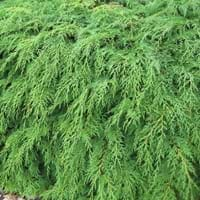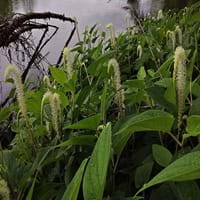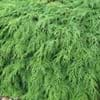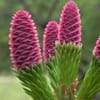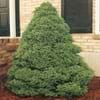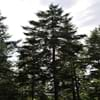Life Span
Perennial
Perennial
Type
Needled or Scaled Evergreen
Aquatics
Origin
Russia/Siberia
Northeastern United States, Mid-Atlantic United States, Southeastern United States, North-Central United States, Central United States, South-Central United States, Canada
Types
Not available
Not Available
Habitat
Cold Regions
Moist Soils, Terrestrial, Upland, Wet lands
USDA Hardiness Zone
4-7
3-11
Sunset Zone
A3, 1a, 1b, 2a, 2b, 3a, 3b, 4, 5, 6, 7, 8, 9, 10, 14, 15, 16, 17
21,22
Habit
Spreading
Thicket/Colonizing
Flower Color
Dark Green
White
Flower Color Modifier
Bicolor
Not Available
Fruit Color
Non Fruiting Plant
Brownish Red
Leaf Color in Spring
Green
Green, Dark Green
Leaf Color in Summer
Green, Dark Green
Green, Dark Green
Leaf Color in Fall
Green, Dark Green, Copper
Green, Dark Green
Leaf Color in Winter
Purple, Sienna, Burgundy, Bronze
Not Available
Leaf Shape
Scale-like imbricate
Heart-shaped
Plant Season
Spring, Summer, Fall, Winter
Spring, Summer, Fall
Sunlight
Full Sun, Partial Sun, Partial shade
Full Sun, Partial Sun, Partial shade
Type of Soil
Clay, Loam
Loam
The pH of Soil
Acidic, Neutral
Acidic, Neutral
Soil Drainage
Well drained
Average
Bloom Time
Not Available
Summer
Tolerances
Shade areas
Wet Site
Where to Plant?
Ground
Container, Ground, Pot
How to Plant?
Seedlings, Semi-hardwood cuttings
From Rhizomes, Root Division
Plant Maintenance
Low
Medium
Watering Requirements
Water during dry weather, Water occasionally
Needs Very high moisture
In Summer
Lots of watering
Lots of watering
In Spring
Moderate
Moderate
In Winter
Average Water
Average Water
Soil pH
Acidic, Neutral
Acidic, Neutral
Soil Type
Clay, Loam
Loam
Soil Drainage Capacity
Well drained
Average
Sun Exposure
Full Sun, Partial Sun, Partial shade
Full Sun, Partial Sun, Partial shade
Pruning
Remove damaged leaves, Remove dead branches, Remove dead leaves
Remove damaged leaves, Remove dead branches, Remove dead leaves
Fertilizers
slow-release fertilizers
All-Purpose Liquid Fertilizer
Pests and Diseases
No serious insect or disease problems
bees
Plant Tolerance
Shade areas
Drought
Flowers
Insignificant
Showy
Flower Petal Number
Single
Single
Foliage Texture
Fine
Medium
Foliage Sheen
Matte
Matte
Attracts
Bees, Butterflies, Hummingbirds
Bees, Flies, Turtles
Allergy
Not Available
allergic reaction, Pollen
Aesthetic Uses
Cottage Garden, Ground Cover
Bog Garden, Showy Purposes, Water gardening, Wild gardens
Beauty Benefits
Not Available
Not Available
Environmental Uses
Not Available
Air purification
Medicinal Uses
Not Available
Insect Bites, Treating fever
Part of Plant Used
Not Available
Flowers, Leaves, Root
Other Uses
Used for bedding in gardens
Grown in botanical gardens as a specimen, Used as Ornamental plant
Used As Indoor Plant
No
Sometimes
Used As Outdoor Plant
Yes
Yes
Garden Design
Alpine, Edging, Feature Plant, Foundation, Groundcover, Mixed Border, Rock Garden, Wall
Container, Water Gardens, Wildflower
Botanical Name
MICROBIOTA decussata
SAURURUS cernuus
Common Name
Microbiota, Siberian carpet cypress, Russian arbor vitae
Lizard's Tail
In Hindi
माइक्रोबायोटा
Saururus cernuus
In German
Mikrobiota
Saururus cernuus
In French
microbiote
Saururus cernuus
In Spanish
microbiota
cernuus Saururus
In Greek
μικροχλωρίδας
Saururus cernuus
In Portuguese
microbiota
Saururus cernuus
In Polish
mikroflory
Saururus cernuus
In Latin
Microbiota
Saururi cernuus
Phylum
Tracheophyta
Tracheophyta
Class
Pinopsida
Magnoliopsida
Family
Cupressaceae
Saururaceae
Genus
Microbiota
Saururus
Clade
Not Available
Angiosperms, Magnoliids
Tribe
Not Available
Not Available
Subfamily
Not Available
Not Available
Number of Species
Not Available
Season and Care of Microbiota and Saururus cernuus
Season and care of Microbiota and Saururus cernuus is important to know. While considering everything about Microbiota and Saururus cernuus Care, growing season is an essential factor. Microbiota season is Spring, Summer, Fall and Winter and Saururus cernuus season is Spring, Summer, Fall and Winter. The type of soil for Microbiota is Clay, Loam and for Saururus cernuus is Loam while the PH of soil for Microbiota is Acidic, Neutral and for Saururus cernuus is Acidic, Neutral.
Microbiota and Saururus cernuus Physical Information
Microbiota and Saururus cernuus physical information is very important for comparison. Microbiota height is 2,330.00 cm and width 120.00 cm whereas Saururus cernuus height is 30.00 cm and width 30.00 cm. The color specification of Microbiota and Saururus cernuus are as follows:
Microbiota flower color: Dark Green
Microbiota leaf color: Green
Saururus cernuus flower color: White
- Saururus cernuus leaf color: Green and Dark Green
Care of Microbiota and Saururus cernuus
Care of Microbiota and Saururus cernuus include pruning, fertilizers, watering etc. Microbiota pruning is done Remove damaged leaves, Remove dead branches and Remove dead leaves and Saururus cernuus pruning is done Remove damaged leaves, Remove dead branches and Remove dead leaves. In summer Microbiota needs Lots of watering and in winter, it needs Average Water. Whereas, in summer Saururus cernuus needs Lots of watering and in winter, it needs Average Water.
